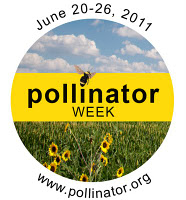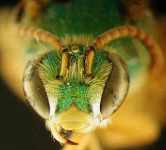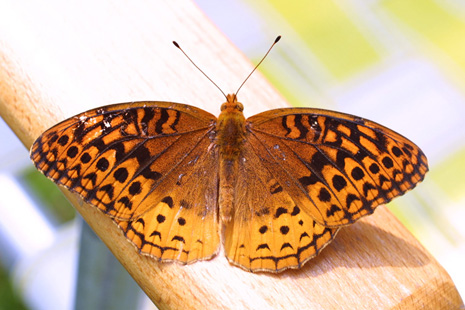The Senate passed Resolution 580 "Recognizing the importance of pollinators to ecosystem health and agriculture in the United States and the value of partnership efforts to increase awareness about pollinators and support for protecting and sustaining pollinators by designating June 24 though June 30, 2007 as 'Pollinator Week'." Read Resolution 580.
Additionally, Mike Johans, Secretary of Agriculture at the United States Department of Agriculture, issued a proclamation calling upon the people of the United States to join in celebrating the vital significance of pollinators to agriculture and to public lands as well as the Department's conservation assistance to farmers and ranchers and its management of ecosystems providing valuable pollinator habitats through the Nation, and recognizing Pollinator Week. Read the Proclamation (University of Arizona Press).
Pollinator Week is June 20 through June 26, 2011. To learn more about this year's events, click here.
The declaration of Pollinator Week was brought about largely through the efforts of the North American Pollinator Protection Campaign (NAPPC).
Showing posts with label pollinators. Show all posts
Showing posts with label pollinators. Show all posts
Tuesday, June 21, 2011
Monday, June 20, 2011
Bee Identification Guide Project Receives Funding to Cover Western Species
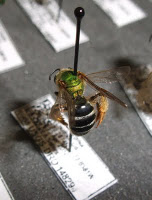 |
| Labeled bee specimen collected in Lovettsville, VA. Photo: Elizabeth Sellers, USGS. |
Monday, May 23, 2011
The Inouye Database: An Interactive Bibliography of Pollination Publications
A new resource for pollinator and pollination research is now available online at www.nbii.gov/inouye. The Inouye Database contains almost 10,000 bibliographic citations from articles and books published from 1793 to the present. It includes some obscure works on pollination biology, flowering phenology, plant demography, and plant-animal interactions such as ant-plant mutualisms, nectar robbing, and animal-mediated pollination.
 |
| Dr. David W. Inouye, Professor, Department of Biology, University of Maryland. Credit: Dr. David Inouye |
Dr. Inouye sought the assistance of the National Biological Information Infrastructure (NBII), a program administered by the U.S. Geological Survey (USGS) to take on task of making it available to the broader research community. The USGS-NBII agreed to Web enable the database and develop an administrative interface that would facilitate updates and maintenance.
As a living dataset that Dr. Inouye and other scientists will continue to contribute to, the Inouye Database is now accessible online and available for others to download in extensible markup language and tab delimited text–file formats.
The USGS-NBII plans to continue collaborating with Dr. Inouye on improvements to the database and welcomes feedback on the Web site and ideas for other potential applications for this type of dataset.
Friday, May 20, 2011
USGS Scientist Participates in Loudoun County, VA, Board of Supervisors Meeting
On June 6, Elizabeth Sellers, Manager – USGS Pollinator Project, will represent the group informally known as the “Bee Team” at a Loudoun County Board of Supervisors meeting. The meeting will be dedicated to recognizing the importance of pollinators (which include bees) as well as noting the state of Virginia’s declaration of National Pollinator Week (June 20-26). Ms. Sellers and the “Bee Team” are currently carrying out the Banshee Reeks Nature Preserve Bee Inventory. Objectives of the inventory include: (1) assess species diversity of this Loudoun County preserve; (2) evaluate the effectiveness of the sampling methodology; and (3) evaluate the feasibility of conducting this type of survey as a citizen science project. The survey was initiated in 2010 with help from Sam Droege of the USGS Patuxent Wildlife Research Center Native Bee Lab. The survey will be completed in October 2011.
(Photo: A male Agapostomen splendens: A bee of sandy areas also known as the "sweat bee." Photographer: Natalie Allen and Stephanie Kolski, U.S. Geological Survey)
(Photo: A male Agapostomen splendens: A bee of sandy areas also known as the "sweat bee." Photographer: Natalie Allen and Stephanie Kolski, U.S. Geological Survey)
Wednesday, March 9, 2011
Internet Catches Updated Butterfly and Moth Website
Why should we care about butterflies and moths? Thanks to butterflies, bees, birds, and other animal pollinators, the world's flowering plants are able to reproduce and bear fruit. That very basic capability is at the root of many of the foods we eat. And, not least, pollination adds to the beauty we see around us.
Yet today, there is evidence of alarming pollinator population declines worldwide. Fortunately, science investigators of this crucial issue can use data collected and organized in the Butterflies and Moths of North America (BAMONA) database to monitor the health of our butterfly and moth population.
Backed by more than 287,000 verified sighting records and 3,239 images that describe 4,638 species, BAMONA is committed to collecting and providing access to quality-controlled data about butterflies and moths of North America. Dedicated volunteer coordinators, including national and internationally recognized Lepidoptera experts, verify each record. The goal is to fill the needs of scientists and nature observers by bringing verified occurrence and life history data into one accessible location.
To serve its broad range of users even better, BAMONA recently launched its re-tooled website. The site was developed at Montana State University (MSU) under a cooperative agreement with the U.S. Geological Survey (USGS) National Biological Information Infrastructure (NBII) Network.
BAMONA’s latest innovations are aimed at improving technologies for both data collection and data dissemination. Users can now submit records – which typically include a photograph – via the site’s new user submission form, replacing an outdated submission process that required multiple e-mails with spreadsheet attachments. As for data dissemination, verified records are now immediately available on the site’s home page. New, interactive Google-based maps enable the display of any verified sighting, including Canadian locations. Visitors can now zoom in or out and click on dots pin-pointing sighting locations on interactive maps, and see the details of each sighting record. All these features were not available previously.
For more information, go to www.butterfliesandmoths.org.
(Photo: The Question Mark (Polygonia interrogationis). Photographer, Bob Moul, 2007. Courtesy of the BAMONA web site).
Yet today, there is evidence of alarming pollinator population declines worldwide. Fortunately, science investigators of this crucial issue can use data collected and organized in the Butterflies and Moths of North America (BAMONA) database to monitor the health of our butterfly and moth population.
Backed by more than 287,000 verified sighting records and 3,239 images that describe 4,638 species, BAMONA is committed to collecting and providing access to quality-controlled data about butterflies and moths of North America. Dedicated volunteer coordinators, including national and internationally recognized Lepidoptera experts, verify each record. The goal is to fill the needs of scientists and nature observers by bringing verified occurrence and life history data into one accessible location.
To serve its broad range of users even better, BAMONA recently launched its re-tooled website. The site was developed at Montana State University (MSU) under a cooperative agreement with the U.S. Geological Survey (USGS) National Biological Information Infrastructure (NBII) Network.
BAMONA’s latest innovations are aimed at improving technologies for both data collection and data dissemination. Users can now submit records – which typically include a photograph – via the site’s new user submission form, replacing an outdated submission process that required multiple e-mails with spreadsheet attachments. As for data dissemination, verified records are now immediately available on the site’s home page. New, interactive Google-based maps enable the display of any verified sighting, including Canadian locations. Visitors can now zoom in or out and click on dots pin-pointing sighting locations on interactive maps, and see the details of each sighting record. All these features were not available previously.
For more information, go to www.butterfliesandmoths.org.
(Photo: The Question Mark (Polygonia interrogationis). Photographer, Bob Moul, 2007. Courtesy of the BAMONA web site).
Tuesday, November 9, 2010
USGS Scientist to Help Develop Bumble Bee Conservation and Research Strategy
USGS Core Science Systems scientist and manager of the Pollinators Project of the National Biological Information Infrastructure program, Elizabeth Sellers, will participate in an invitation-only IUCN North American Bumble Bee Species Conservation Strategy workshop in St. Louis, MO, on November 9-12, 2010. Bumble bees are among the most important wild pollinators in both agricultural and natural ecosystems. The population declines that have been noted in several species of formerly common North American bumble bees underscore the need to develop a coordinated conservation and research strategy. Facilitated by the International Union for Conservation of Nature (IUCN) Conservation Breeding Specialist Group, the main goal of the workshop is to develop a comprehensive strategy that will direct future research and conservation work on imperiled North American bumble bees.
(Photo: Bumblebee (Bombus sp.) on a dame's rocket flower. Credit: Elizabeth A. Sellers /life.nbii.gov)
(Photo: Bumblebee (Bombus sp.) on a dame's rocket flower. Credit: Elizabeth A. Sellers /life.nbii.gov)
Friday, September 10, 2010
Discover Life’s Video of Bee Hunt Project Data Collection Protocol
There’s a new five-minute online video describing how to take scientifically useful photographs of insects. Whether for invasive species data collection or pollinator studies, Discover Life’s video shows how to take more effective photographs in the field. Thanks to their partnership with the NBII’s Invasive Species Information Node (ISIN), all of Discover Life’s tools are free via the Web. They are rallying citizen scientists to monitor bees, fungi, lichens, ladybugs, moths, butterflies, caterpillars, and goldenrods. The video can be viewed online at the Discover Life Web site.
(Photo: Honey bee (Apis mellifera) on a daisy in Africa. Credit: Elizabeth A. Sellers /life.nbii.gov)
NBII Acting in Cupid’s Service
The NBII is typically presented as a broad, collaborative program to provide increased access to data and information on the nation’s biological resources. We often add that resource managers, scientists, educators, and the general public use the NBII to answer a wide range of questions related to the management, use, or conservation of this nation’s biological resources.
True enough. But when we talk about the general public using the NBII, occasionally the motivation has more to do with biological drives than biological resources (which is maybe not so surprising since without biological drives there wouldn’t be any biological resources).
That said, consider two perspectives on the topic of butterflies, one of many NBII specialties:
So where’s the connection? Actually, it was brought to our attention by an alert aunt and wedding planner who was cruising our butterflies and moths site not so long ago and recalled to us that she wanted to have a butterfly-themed wedding for her niece. She and her niece were planning the details and scouring the net for resources that would ensure this theme was (I) do-able. It seems they needed reliable information on a wide variety of butterfly species, and the NBII site was among the most engaging they visited.
“Thanks for the [butterfly] resources you provided,” our supportive inquirer said. “They have really helped my niece out.”
Elizabeth Sellers, Manager of the NBII Pollinators Project, thanked the writer for her kind words and added that our site was just another example of the NBII’s longstanding theme of Building Knowledge Through Partnerships: “Our Butterflies and Moths Web page was produced through our partnership with the Ecological Society of America (ESA) and with input from members of the North American Pollinator Protection Campaign .”
Disclosures aside, while resource managers turn to our site most often seeking resources to help build and maintain healthy ecosystems, sometimes we can also provide valuable assistance to those more attuned to building healthy, long-term relationships. In any event, we’re glad to be of service to all — including Cupid!
True enough. But when we talk about the general public using the NBII, occasionally the motivation has more to do with biological drives than biological resources (which is maybe not so surprising since without biological drives there wouldn’t be any biological resources).
That said, consider two perspectives on the topic of butterflies, one of many NBII specialties:
- The first is from our NBII Pollinators Web site, which features a focus on North American butterflies and moths, members of the order Lepidoptera.
- The second is from country music legend and poet Dolly Parton, who wrote: “Love is like a butterfly, as soft and gentle as a sigh, the multicolored moods of love are like its satin wings.”
So where’s the connection? Actually, it was brought to our attention by an alert aunt and wedding planner who was cruising our butterflies and moths site not so long ago and recalled to us that she wanted to have a butterfly-themed wedding for her niece. She and her niece were planning the details and scouring the net for resources that would ensure this theme was (I) do-able. It seems they needed reliable information on a wide variety of butterfly species, and the NBII site was among the most engaging they visited.
“Thanks for the [butterfly] resources you provided,” our supportive inquirer said. “They have really helped my niece out.”
Elizabeth Sellers, Manager of the NBII Pollinators Project, thanked the writer for her kind words and added that our site was just another example of the NBII’s longstanding theme of Building Knowledge Through Partnerships: “Our Butterflies and Moths Web page was produced through our partnership with the Ecological Society of America (ESA) and with input from members of the North American Pollinator Protection Campaign .”
Disclosures aside, while resource managers turn to our site most often seeking resources to help build and maintain healthy ecosystems, sometimes we can also provide valuable assistance to those more attuned to building healthy, long-term relationships. In any event, we’re glad to be of service to all — including Cupid!
Monday, July 19, 2010
Enhancements Underway for Butterflies and Moths of North America Database
 As part of a multi-Node effort supported by the NBII in 2009, the Big Sky Institute (BSI) continues to enhance the national Butterflies and Moths of North America (BAMONA) database. Most of the data has been transferred to the new database for the Drupal-based Web site that allows for listing of species information by family, subfamily, etc. Additional views are being developed including for images, which will allow users to sort images by family. In the geographic area, the benefits of updating the site include the addition of a filter box for displaying species information by states/provinces; by geographic area or by subfamily or other user specified parameters. The new Web site will be launched in Fall 2010. For current information, go to http://www.butterfliesandmoths.org.
As part of a multi-Node effort supported by the NBII in 2009, the Big Sky Institute (BSI) continues to enhance the national Butterflies and Moths of North America (BAMONA) database. Most of the data has been transferred to the new database for the Drupal-based Web site that allows for listing of species information by family, subfamily, etc. Additional views are being developed including for images, which will allow users to sort images by family. In the geographic area, the benefits of updating the site include the addition of a filter box for displaying species information by states/provinces; by geographic area or by subfamily or other user specified parameters. The new Web site will be launched in Fall 2010. For current information, go to http://www.butterfliesandmoths.org. (Photo: Ailanthus webworm moth (Atteva punctella) on Goldenrod (Solidago sp.) flowers. Credit: © 2008 Elizabeth A. Sellers, Courtesy of life.nbii.gov)
Tuesday, July 6, 2010
Invasive Species, Pollinators, and the Encyclopedia of Life (EoL)

USGS biological informatics scientists Elizabeth Sellers (NBII Invasive Species, Pollinators), Annie Simpson (NBII Invasive Species), and Gerald Guala (Integrated Taxonomic Information System, botany) have been invited to contribute their expertise on invasive species, pollinators, and botany at the Encyclopedia of Life's Taxonomic Triage Workshop, July 7-8 at the Smithsonian National Museum of Natural History in Washington D.C. The workshop will inform and improve the EOL’s ability to prioritize content acquisition in the coming year and beyond. In particular, Ms. Simpson and Ms. Sellers will assist EOL in identifying key species and information gaps and priorities in EOL's taxonomic coverage of invasive and pollinating species - two groups for which more species information is needed for effective management and control in the case of invasive species; and for conservation in the case of pollinators, many of which are showing marked population decreases. Dr. Guala will provide his botanical and taxonomic expertise toward the overall task of determining what content is required for a rich species page and which vascular plant groups are a priority for inclusion in EOL.
Photo: Neon Cuckoo Bee (Thyreus nitidulus). © Elizabeth Sellers 2009).
Labels:
Bees,
invasive species,
invasives,
pollinators
Wednesday, June 23, 2010
Butterflies and Moths of North America Presented at Lepidopterists’ Society
The Butterflies and Moths of North America (BAMONA) project is supported through a partnership among the USGS National Biological Information Infrastructure (NBII), the Big Sky Institute at Montana State University, and the USGS Northern Prairie Wildlife Research Center. NBII Partner Kelly Lotts will present a poster and oral presentation about this project at the 59th Annual Meeting of the Lepidopterists' Society (LepSoc 2010), July 8-11, 2010 in Leavenworth, WA. What began as two independent repositories of butterfly and moth county records compiled for lepidopterists, BAMONA has grown into a vast citizen science project with hundreds of volunteers. As of May, the BAMONA Web site provided access to a database of more than 275,000 butterfly and moth occurrence records, over 3,000 photographs, and more than 4,500 species pages. Quality-controlled data contributed by lepidopterists and citizen scientists from across the United States and Mexico are publicly available via checklists and maps. By fall, the BAMONA project will take another big leap when a new version of the Web site is launched to the public. This improved BAMONA site will include Canadian data, maps displaying point data and recent submissions, and a new online, streamlined submission/review process. In addition, a Web Mapping Service of the BAMONA data will be published so that interested scientists can utilize these data in mapping applications. At LepSoc 2010, Ms. Lotts will strengthen existing collaborations with the Lepidopterists' Society, seek new partnerships with amateur and professional lepidopterists, and promote public participation and use of this international dataset.
Photo: Echo Azure (Celastrina echo). Photo by © Kelly Lotts.
Photo: Echo Azure (Celastrina echo). Photo by © Kelly Lotts.
Labels:
butterflies,
lepidoptera,
moths,
pollinators
Wednesday, June 16, 2010
USGS Pollinator Research and Bioinformatics Showcase on the National Mall
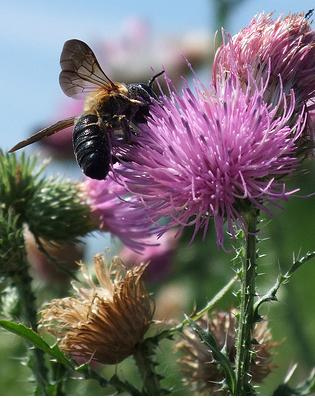 U.S. Geological Survey (USGS) Scientists Steve Hilburger (Program Analyst, USGS Wildlife Program), Sam Droege (Wildlife Biologist, USGS Patuxent Wildlife Research Center and Coordinator of the USGS Native Bee Inventory and Monitoring Laboratory), and Elizabeth Sellers (Manager, Pollinators Project of the USGS National Biological Information Infrastructure) will showcase examples of USGS pollinator research and biological informatics tools at the Inter-departmental National Pollinator Week Exhibit hosted by the U.S. Department of Agriculture (USDA) beside the National Mall (adjacent to the USDA People's Garden) in Washington D.C. on June 21, 2010. This event builds on the cooperative energy initiated at an inter-departmental pollinator collaboration meeting hosted by USDA in March, and provides an opportunity for more pollinator-related information exchange and discussion among Federal agencies and with the public. National Pollinator Week is from June 21-27, 2010.
U.S. Geological Survey (USGS) Scientists Steve Hilburger (Program Analyst, USGS Wildlife Program), Sam Droege (Wildlife Biologist, USGS Patuxent Wildlife Research Center and Coordinator of the USGS Native Bee Inventory and Monitoring Laboratory), and Elizabeth Sellers (Manager, Pollinators Project of the USGS National Biological Information Infrastructure) will showcase examples of USGS pollinator research and biological informatics tools at the Inter-departmental National Pollinator Week Exhibit hosted by the U.S. Department of Agriculture (USDA) beside the National Mall (adjacent to the USDA People's Garden) in Washington D.C. on June 21, 2010. This event builds on the cooperative energy initiated at an inter-departmental pollinator collaboration meeting hosted by USDA in March, and provides an opportunity for more pollinator-related information exchange and discussion among Federal agencies and with the public. National Pollinator Week is from June 21-27, 2010.(Photo: Giant resin bee (Megachile sculpturalis) on thistle. Franklin Park, Purcellville, VA. © Elizabeth Sellers 2009).
Labels:
Bees,
National Pollinator Week,
pollinators
Thursday, May 20, 2010
NBII and USGS Represented at Congressional Pollinator Protection Caucus Launch
Ms. Elizabeth Sellers, Manager, NBII, Pollinators Project, and Steve Hilburger, Program Analyst, USGS Wildlife Program, represented NBII biological informatics and USGS research science on pollinators at a Pollinator Briefing held on April 12 in Washington, DC, at the Longworth House Office Building in conjunction with the launch of a new Congressional Pollinator Protection Caucus, co-chaired by Representatives Alcee L. Hastings and Timothy V. Johnson. Ms. Sellers and Mr. Hilburger are also active members of the Steering Committee of the North American Pollinator Protection Campaign (NAPPC), one of the supporters of this event.
(Photo: Brown belted bumblebee (Bombus griseocollis) on thistle. Franklin Park, Purcellville, Virginia. Photo Credit: © Elizabeth Sellers. All Rights Reserved 2010).
(Photo: Brown belted bumblebee (Bombus griseocollis) on thistle. Franklin Park, Purcellville, Virginia. Photo Credit: © Elizabeth Sellers. All Rights Reserved 2010).
Thursday, February 4, 2010
Integrated Taxonomic Information System (ITIS) Offers Additional Butterfly Data
Working with butterfly specialists nationwide, the Integrated Taxonomic Information System (ITIS) (a vital USGS-NBII component) has recently made a large quantity of new information on North American butterflies available. More than 3,600 scientific names and 1,000 common names for more than 800 species and 1,600 subspecies are now included. The comprehensive list contains both scientific and common names with associated data for this important group that includes numerous pollinators and endangered species as well as some invasive species. For more information, visit the ITIS website.
(Photo: A monarch butterfly (Danaus plexippus) feeding on a thistle flower. Photo Credit: Elizabeth A. Sellers/life.nbii.gov.)
(Photo: A monarch butterfly (Danaus plexippus) feeding on a thistle flower. Photo Credit: Elizabeth A. Sellers/life.nbii.gov.)
Saturday, June 13, 2009
Blog and RSS Feed Launched for Butterflies and Moths of North America Database
The Butterflies and Moths of North America Database (BAMONA) launched the BAMONA Blog in March 2009. This blog provides real time updates about entries to the database such as the addition of new photographs, new records, and new species accounts. Blog posts are tagged with the type of update, the coordinator’s name, and geographic location. Posts can be sorted by these tags, so users can view a sub-set of posts that are relevant to them. The blog has a main RSS feed and individual feeds for each tag. The Mountain Prairie Information Node (MPIN) and the NBII Pollinators Web sites are consuming the main BAMONA Blog RSS. Other NBII Nodes and Projects are welcome to add the RSS feed to their site. Click here to see an example of the blog feed on the Mountain Prairie Information Node website.
(Photo: Gulf fritillary (Agraulis vanillae) in ironweed. Photo used with permission from © Vicki DeLoach/Vicki's Nature, on Flickr.)
(Photo: Gulf fritillary (Agraulis vanillae) in ironweed. Photo used with permission from © Vicki DeLoach/Vicki's Nature, on Flickr.)
Subscribe to:
Posts (Atom)

